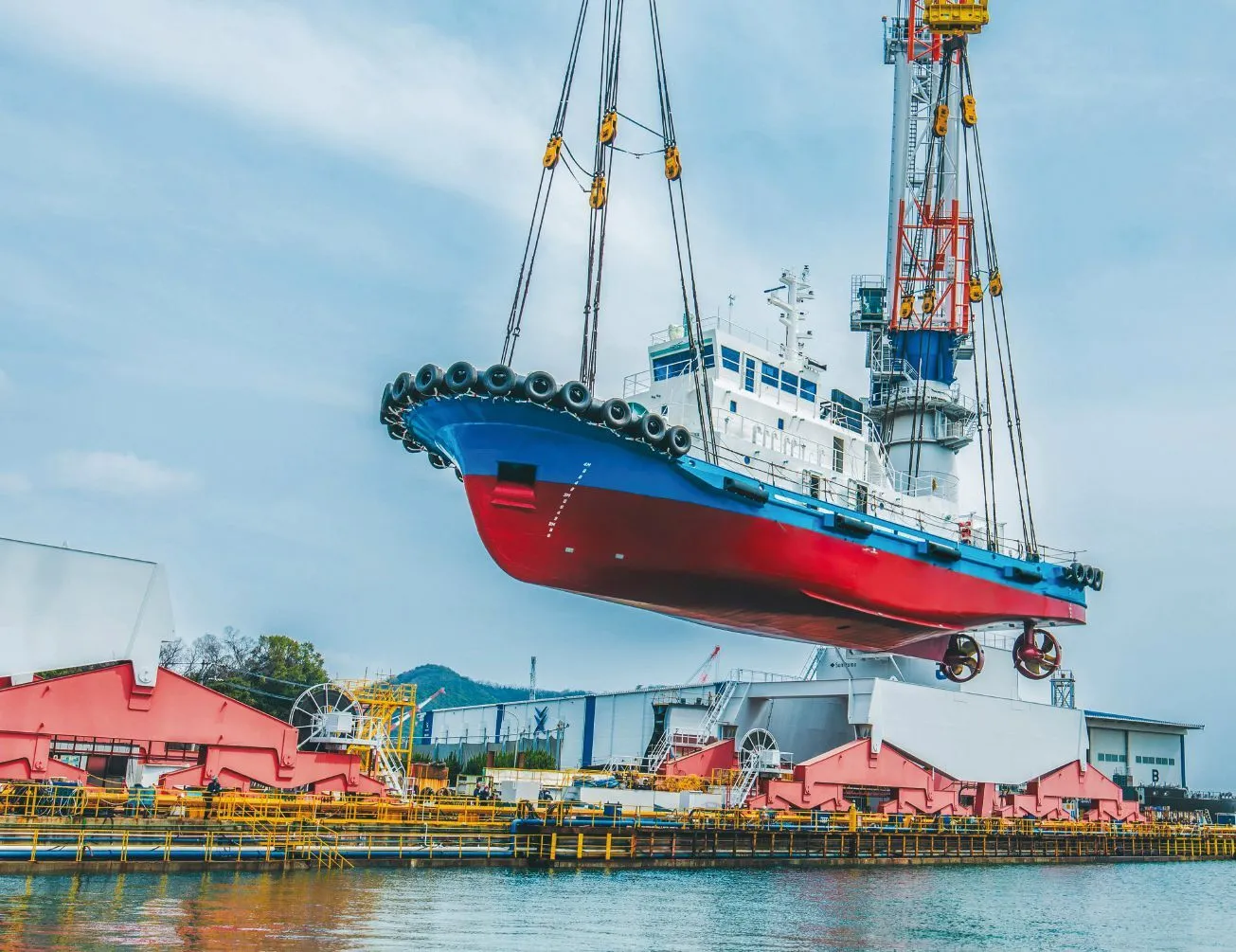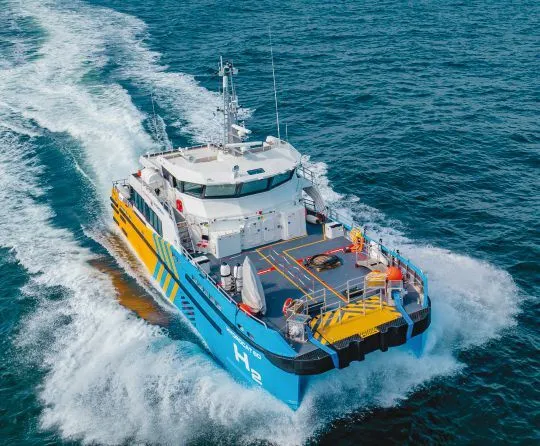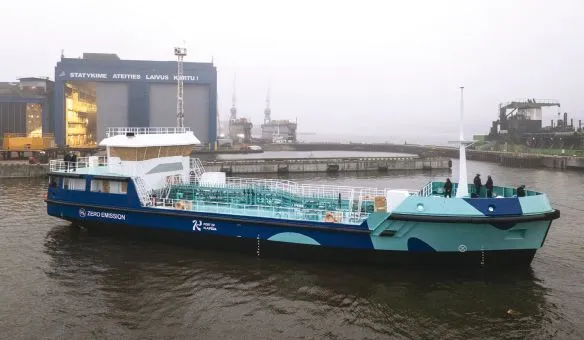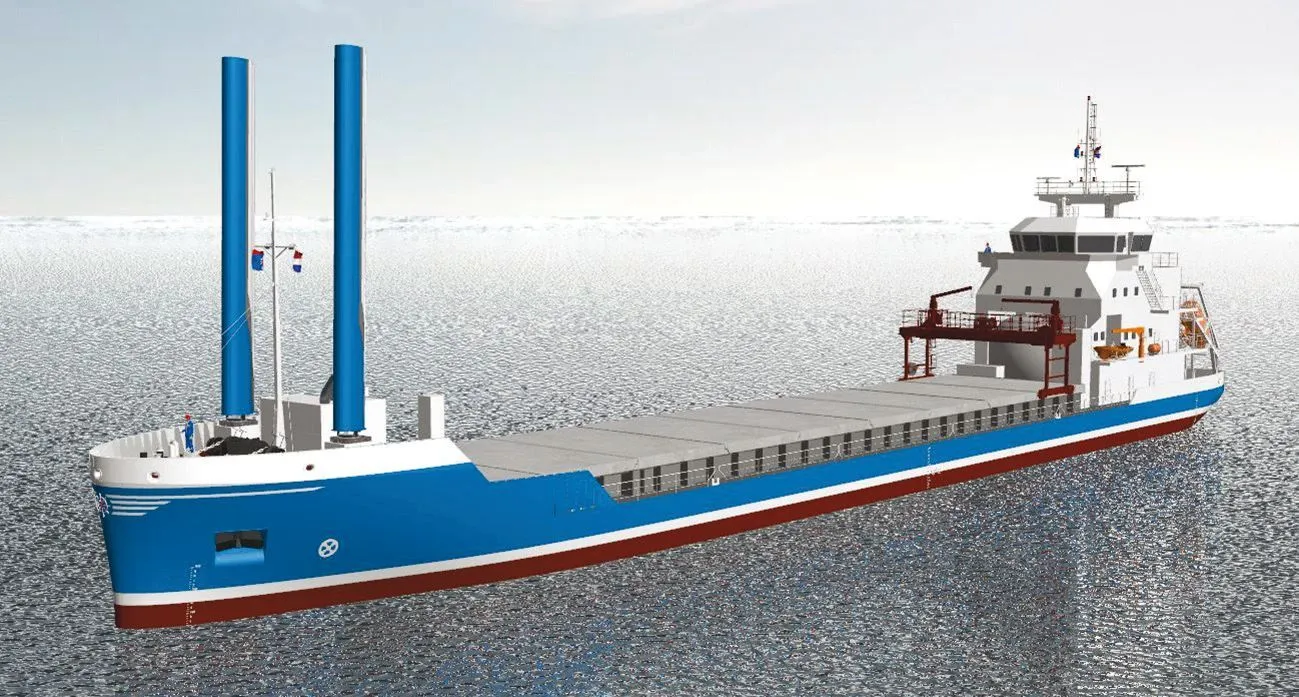E&H Marine rounds up some of the most exciting new vessel projects that will utilize hydrogen fuel cells.
Viking and Fincantieri announce hydrogen-powered cruise ship
April saw Viking and Fincantieri announce details of the Viking Libra, the world’s first hydrogen-powered cruise ship, capable of operating with zero emissions. Already under construction at Fincantieri’s Ancona shipyard, the Viking Libra is scheduled for delivery in late 2026. Viking’s subsequent ocean ship, the Viking Astrea, currently under construction and scheduled for delivery in 2027, will also be hydrogen powered.
Classified as a small ship – as are all Viking ocean ships – the Viking Libra will have a gross tonnage of approximately 54,300 tons, with 499 staterooms that can host 998 guests. The vessel will have a propulsion system partially based on liquefied hydrogen and fuel cells. This hybrid propulsion system will make her capable of navigating and operating with zero emissions, allowing access to even the most environmentally sensitive areas. Fincantieri subsidiary Isotta Fraschini Motori (IFM), which specializes in advanced fuel cell technology, will enable the ship’s state-of-the-art propulsion system, which will be capable of producing up to 6MW of power.
“From the outset, we have designed our river and ocean ships thoughtfully to reduce their fuel consumption, and we are very proud the Viking Libra and the Viking Astrea will be even more environmentally friendly,” said Torstein Hagen, chairman and CEO of Viking. “Viking made the principled decision to invest in hydrogen, which offers a true zero-emission solution. We look forward to welcoming the world’s first hydrogen-powered cruise ship to our fleet in 2026.”
“With the Viking Libra, we are not only delivering the world’s first cruise ship powered by hydrogen stored on board, but we are also reinforcing our commitment to shaping the future of sustainable maritime transportation,” added Pierroberto Folgiero, CEO and managing director of Fincantieri. “Furthermore, we are thrilled about Viking’s decision to expand its fleet with the order of two additional ships, which reaffirms the strength of our partnership and the trust placed in our expertise. This new order is a testament to our shared vision for a more sustainable cruise industry, as together we continue to set new standards for innovation and responsible shipbuilding.”
As mentioned by Folgiero, Viking and Fincantieri have signed contracts for two additional ocean ships for delivery in 2031 and an option for two additional ocean ships for delivery in 2033.
Japan’s first hydrogen-powered tugboat launched

Tsuneishi Shipbuilding has launched Japan’s first tugboat equipped with a hydrogen-powered internal combustion engine. This vessel, which was launched on March 28, is equipped with a high-power-output hydrogen dual-fuel ICE and a high-pressure hydrogen gas storage system with large capacity and supply. The vessel was developed and built as part of the Nippon Foundation’s Zero Emission Ships Project, which aims to develop vessels with zero CO₂ emissions.
Tugboats must be highly maneuverable and have high engine output. The hydrogen tug has twin 12-cylinder hydrogen-blended engines, with the goal of reducing vessel CO2 emissions by approximately 60% compared with conventional tugs. With approximately 250kg of high-pressure hydrogen gas storage on board, the boat can maintain the same operational performance as tugs using conventional fuel. In the unlikely event of a failure in the hydrogen fuel system, the vessel can operate with traditional marine fuels.
“We have successfully launched our first hydrogen-fueled tugboat,” said Nishijima Takanori, general manager of the design division and managing executive officer of Tsuneishi Shipbuilding. “We will utilize the know-how and design processes we have developed in the construction of hydrogen-fueled tugboats, which require high power, in the construction of further new-fuel vessels. Our company is working to achieve carbon neutrality by developing and constructing new-fuel vessels such as methanol-fueled, LNG- fueled and hydrogen-fueled vessels, making use of group synergies.”
“We have successfully launched our first hydrogen-fueled tugboat“ Nishijima Takanori, Tsuneishi Shipbuilding
Windcat delivers first hydrogen-powered CTV

In March 2025, Windcat delivered the Hydrocat 60, the second vessel in its MK5 series of crew transfer vessels and the first to be fitted with a full hydrogen-fueled dual-fuel system.
The hydrogen combustion engine was co-developed by CMB.Tech and MAN, and makes it possible for the vessel to operate on both hydrogen and traditional diesel fuel. The Hydrocat 60 can store up to 458kg of compressed hydrogen on board.
“We are very proud to now have the third hydrogen-powered CTV in operation within the Windcat fleet,” said Willem van der Wel, MD of Windcat. “We see that hydrogen is building momentum in the offshore wind industry and is already contributing toward the reduction of our customers’ CO2 emissions today. With more hydrogen-ready vessels already in the water and under construction, we continue to answer the increasing demand for clean, high-performance CTVs.”
The MK5 design offers optimized seakeeping capabilities, larger deck space and provision for increased hydrogen storage. The vessel has an overall length of 27m, and features an optimized hull shape, increased width and elevated freeboard.
Windcat is so confident that hydrogen technology will continue to gain traction in the maritime and offshore sector that all newly constructed MK5 vessels will be fitted with a dual-fuel hydrogen engine as standard.
Klaipėda Port’s first hydrogen-powered tanker takes to the water

January 2025 saw Lithuania’s first green hydrogen- and electricity-powered ship, commissioned by the Klaipėda State Seaport Authority, moved from the shipyard into the water.
The 42m-long and 10m-wide tanker’s main function is to collect storm water, sewage, sludge and garbage, as well as to ensure efficient waste management. The ship is equipped with special tanks and a modern rainwater treatment plant to allow the treated water to be transferred to the city’s sewage treatment plants.
The onboard power system consists of two electric motors powered by 2,000kWh batteries and a hydrogen fuel cell system. The €12m (US$13.6m) project was commissioned by the Klaipėda State Seaport Authority and is being built by Western Baltija Shipbuilding and Baltic Workboats under a joint operating agreement.
“We have not only launched a tanker, but also a new approach to port operations – cleaner, smarter and more environmentally friendly,” explained Algis Latakas, director general of Klaipėda State Seaport Authority. “This first-ever hydrogen- and electricity-powered ship is not only an innovative technological solution, but also an important step in strengthening Lithuania’s image as a modern maritime nation. At the moment, the tanker is getting used to the seaport water, so to speak, and at the end of the year we expect it to start its important mission of taking care of the clean seaport environment.”
According to the current rules, vessels are obliged to hand over the waste they produce when they arrive and before they leave Klaipėda Port. The Seaport Authority is entrusted with the collection of that waste – and the decision was taken to use modern and environmentally friendly equipment to improve the quality of the ship waste collection service.
NIM to lead consortium for hydrogen-powered cargo ship

Dutch company NIM is leading a project to develop the world’s first zero-emission general cargo ship powered by liquid hydrogen. The H2ESTIA Project is supported by the Dutch Ministry of Infrastructure and Water Management.
The project focuses on designing, constructing and demonstrating a hydrogen-powered cargo vessel that will operate in the North Sea and beyond. Managed by Van Dam Shipping, the ship will transport bulk goods without harmful emissions – and looks set to play a key role in redefining the feasibility of sustainable shipping.
“We’re proving that zero-emission shipping is not just a vision – it is an achievable reality” Sander Roosjen, NIM
At the heart of the H2ESTIA Project is an integrated approach to hydrogen-powered propulsion – the vessel will be equipped with a newly designed cryogenic hydrogen storage and bunkering system, enabling safe handling and storage of liquid hydrogen at extremely low temperatures. A hydrogen fuel cell system together with batteries will provide the primary propulsion power. In addition, the ship will incorporate wind-assisted propulsion and waste heat recovery solutions, reducing hydrogen consumption. Digital twin technology will create a virtual model of the ship, enabling real-time monitoring, operational optimization and enhanced safety measures.
“H2ESTIA is a flagship project for commercial shipping,” said Sander Roosjen, CTO at NIM. “By integrating hydrogen technology with digital innovation, we’re proving that zero-emission shipping is not just a vision – it is an achievable reality.”
The project is set to demonstrate technological readiness and economic viability, ensuring such vessels can be commercially deployed. It also aims to address major challenges such as the certification of hydrogen systems, risk management and crew training, paving the way for the safe integration of hydrogen technology into maritime operations.
“Parallel to the H2ESTIA Project, we are working on securing the supply, as well as the necessary bunkering and logistics,” added Jan van Dam, CEO of Van Dam Shipping. “This is a combined effort, as a single ship alone does not generate sufficient demand. Collaboration at this stage is what transforms our ambitions into reality.”
The H2ESTIA Project is supported by a consortium of maritime and technology companies – TNO, MARIN, the University of Twente, Cryovat, EnginX, Encontech, RINA and the Dutch Ministry of Infrastructure and Water Management.
This article was originally published in the April/May 2025 issue of Electric and Hybrid Marine Technology. To view the magazine in full, click here.



